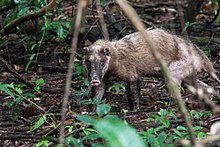Greater hog badger
| Greater hog badger | |
|---|---|

| |
| Greater hog badger in Huai Kha Khaeng Wildlife Sanctuary, Thailand | |
| Scientific classification | |
| Domain: | Eukaryota |
| Kingdom: | Animalia |
| Phylum: | Chordata |
| Class: | Mammalia |
| Order: | Carnivora |
| Family: | Mustelidae |
| Genus: | Arctonyx |
| Species: | A. collaris
|
| Binomial name | |
| Arctonyx collaris Cuvier, 1825
| |

| |
The greater hog badger (Arctonyx collaris) is a very large terrestrial
Taxonomy
It was formerly thought to be the only species in the genus Arctonyx, displaying heavy variation throughout its wide range, leading it to be classified as having many subspecies. However, a 2008 study found that Arctonyx should be split into three species.[2] The following
- Greater hog badger A. c. collaris (Cuvier, 1825) – lives in the Eastern Himalayas;[5]
- Indochinese hog badger A. c. dictator (Thomas, 1910) – lives in southern Thailand and Indochina;[5]
- Burmese hog badger A. c. consul (Pocock, 1940) – occurs from Assam to Myanmar.[5]
Description
The greater hog badger has medium-length brown hair, a stocky body, white throat, two black stripes on an elongated white snout, with a pink, pig-like nose. The snout-to-rump length is 65–104 cm (26–41 in), the tail measures 19–29 cm (7.5–11.4 in) and the body weight is 7–14 kg (15–31 lb).[6][2]
With weights regularly reported between 8.4 to 12 kg (19 to 26 lb), it is one of the world's largest terrestrial extant mustelids (by average body mass). It is perhaps only second or third to the wolverine, rivaling the European badger; However, hog badgers are not known to rival the weights of the European badger during autumn hyperphagia.[7][8]
A hog badger's appearance generally resembles the European badger, but having a pronounced pig-like snout, and with larger claws on the front feet. Its tail has long white hairs, and its front feet have white claws.
Distribution and habitat
The greater hog badger is considered fairly common in
Behaviour and ecology
The hog badger is active by day and not very wary of humans.[10] Analysis of numerous camera trap pictures from Myanmar show no peak activity at either day or night.[11]
The hog badger is omnivorous; its diet consists of fruits, roots and small animals.[citation needed] A study conducted in Laos found that the native clouded leopards eat a large proportion of greater hog badgers, accounting for 28% of their diet.[12]
References
- ^ . Retrieved 20 November 2021.
- ^ PMID 32287392.
- OCLC 62265494.
- ^ "Arctonyx collaris F. Cuvier, 1825". ASM Mammal Diversity Database. American Society of Mammalogists. Retrieved 2021-06-25.
- ^ a b c Ellerman, J. R. and Morrison-Scott, T. C. S. (1966). Checklist of Palaearctic and Indian mammals 1758 to 1946. Second edition. British Museum of Natural History, London. Pages 274–275.
- ISBN 978-0-671-42805-1
- ^ Zhang, L., Zhou, Y. B., Newman, C., Kaneko, Y., Macdonald, D. W., Jiang, P. P. & Ding, P. (2009). Niche overlap and sett-site resource partitioning for two sympatric species of badger. Ethology Ecology & Evolution, 21(2), 89-100.
- ^ Parker, C. (1979). Birth, care and development of Chinese hog badgers. International Zoo Yearbook, 19(1), 182-185.
- ^ Than Zaw, Saw Htun, Saw Htoo Tha Po, Myint Maung, Lynam, A. J., Kyaw Thinn Latt and Duckworth, J. W. (2008). Status and distribution of small carnivores in Myanmar. Small Carnivore Conservation 38: 2–28.
- ^ Duckworth, J. W., Salter, R. E. and Khounbline, K. (1999). Wildlife in Lao PDR: 1999 Status Report. IUCN, Vientiane, Laos.
- ^ Than Zaw, Saw Htun, Saw Htoo Tha Po, Myint Maung, Lynam, A. J., Kyaw Thinn Latt and Duckworth, J. W. (2008). Status and distribution of small carnivores in Myanmar Archived 2015-04-28 at the Wayback Machine. Small Carnivore Conservation 38: 2–28.
- PMID 35813929. Retrieved 2023-02-09.

